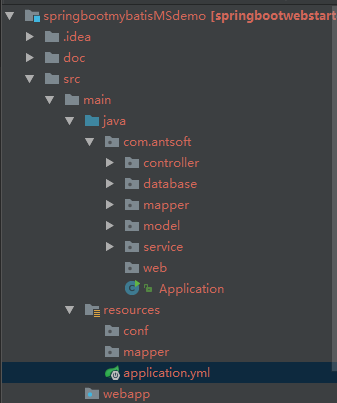本文將介紹使用Spring Boot集成Mybatis并實現主從庫分離的實現(同樣適用于多數據源)。延續之前的Spring Boot 集成MyBatis。項目還將集成分頁插件PageHelper、通用Mapper以及Druid。
新建一個Maven項目,最終項目結構如下:

多數據源注入到sqlSessionFactory
POM增加如下依賴:
|
1
2
3
4
5
6
7
8
9
10
11
12
13
14
15
16
17
18
19
20
21
22
23
24
25
26
27
28
29
30
31
32
33
34
35
36
37
38
39
40
41
42
43
44
45
46
47
48
49
50
51
52
53
54
55
|
<!--JSON--> <dependency> <groupId>com.fasterxml.jackson.core</groupId> <artifactId>jackson-core</artifactId> </dependency> <dependency> <groupId>com.fasterxml.jackson.core</groupId> <artifactId>jackson-databind</artifactId> </dependency> <dependency> <groupId>com.fasterxml.jackson.datatype</groupId> <artifactId>jackson-datatype-joda</artifactId> </dependency> <dependency> <groupId>com.fasterxml.jackson.module</groupId> <artifactId>jackson-module-parameter-names</artifactId> </dependency> <dependency> <groupId>org.springframework.boot</groupId> <artifactId>spring-boot-starter-jdbc</artifactId> </dependency> <dependency> <groupId>mysql</groupId> <artifactId>mysql-connector-java</artifactId> </dependency> <dependency> <groupId>com.alibaba</groupId> <artifactId>druid</artifactId> <version>1.0.11</version> </dependency> <!--mybatis--> <dependency> <groupId>org.mybatis.spring.boot</groupId> <artifactId>mybatis-spring-boot-starter</artifactId> <version>1.1.1</version> </dependency> <!--mapper--> <dependency> <groupId>tk.mybatis</groupId> <artifactId>mapper-spring-boot-starter</artifactId> <version>1.1.0</version> </dependency> <!--pagehelper--> <dependency> <groupId>com.github.pagehelper</groupId> <artifactId>pagehelper-spring-boot-starter</artifactId> <version>1.1.0</version> <exclusions> <exclusion> <artifactId>mybatis-spring-boot-starter</artifactId> <groupId>org.mybatis.spring.boot</groupId> </exclusion> </exclusions> </dependency> |
這里需要注意的是:項目是通過擴展mybatis-spring-boot-starter的org.mybatis.spring.boot.autoconfigure.MybatisAutoConfiguration來實現多數據源注入的。在mybatis-spring-boot-starter:1.2.0中,該類取消了默認構造函數,因此本項目依舊使用1.1.0版本。需要關注后續版本是否會重新把擴展開放處理。
之所以依舊使用舊方案,是我個人認為開放擴展是合理的,相信在未來的版本中會回歸。
如果你需要其他方案可參考傳送門
增加主從庫配置(application.yml)
|
1
2
3
4
5
6
7
8
9
10
11
12
13
14
15
16
17
18
19
20
|
druid: type: com.alibaba.druid.pool.DruidDataSource master: url: jdbc:mysql://192.168.249.128:3307/db-test?characterEncoding=UTF-8&autoReconnect=true&zeroDateTimeBehavior=convertToNull&useUnicode=true driver-class-name: com.mysql.jdbc.Driver username: root password: root initial-size: 5 min-idle: 1 max-active: 100 test-on-borrow: true slave: url: jdbc:mysql://192.168.249.128:3317/db-test?characterEncoding=UTF-8&autoReconnect=true&zeroDateTimeBehavior=convertToNull&useUnicode=true&characterEncoding=utf-8 driver-class-name: com.mysql.jdbc.Driver username: root password: root initial-size: 5 min-idle: 1 max-active: 100 test-on-borrow: true |
創建數據源
|
1
2
3
4
5
6
7
8
9
10
11
12
13
14
15
16
17
18
19
20
|
@Configuration@EnableTransactionManagementpublic class DataSourceConfiguration { @Value("${druid.type}") private Class<? extends DataSource> dataSourceType; @Bean(name = "masterDataSource") @Primary @ConfigurationProperties(prefix = "druid.master") public DataSource masterDataSource(){ return DataSourceBuilder.create().type(dataSourceType).build(); } @Bean(name = "slaveDataSource") @ConfigurationProperties(prefix = "druid.slave") public DataSource slaveDataSource1(){ return DataSourceBuilder.create().type(dataSourceType).build(); }} |
將多數據源注入到sqlSessionFactory中
前面提到了這里通過擴展mybatis-spring-boot-starter的org.mybatis.spring.boot.autoconfigure.MybatisAutoConfiguration來實現多數據源注入的
|
1
2
3
4
5
6
7
8
9
10
11
12
13
14
15
16
17
18
19
20
21
22
23
24
25
26
|
@Configuration@AutoConfigureAfter({DataSourceConfiguration.class})public class MybatisConfiguration extends MybatisAutoConfiguration { private static Log logger = LogFactory.getLog(MybatisConfiguration.class); @Resource(name = "masterDataSource") private DataSource masterDataSource; @Resource(name = "slaveDataSource") private DataSource slaveDataSource; @Bean public SqlSessionFactory sqlSessionFactory() throws Exception { return super.sqlSessionFactory(roundRobinDataSouceProxy()); } public AbstractRoutingDataSource roundRobinDataSouceProxy(){ ReadWriteSplitRoutingDataSource proxy = new ReadWriteSplitRoutingDataSource(); Map<Object,Object> targetDataResources = new ClassLoaderRepository.SoftHashMap(); targetDataResources.put(DbContextHolder.DbType.MASTER,masterDataSource); targetDataResources.put(DbContextHolder.DbType.SLAVE,slaveDataSource); proxy.setDefaultTargetDataSource(masterDataSource);//默認源 proxy.setTargetDataSources(targetDataResources); return proxy; }} |
實現讀寫分離(多數據源分離)
這里主要思路如下:
1-將不同的數據源標識記錄在ThreadLocal中
2-通過注解標識出當前的service方法使用哪個庫
3-通過Spring AOP實現攔截注解并注入不同的標識到threadlocal中
4-獲取源的時候通過threadlocal中不同的標識給出不同的sqlSession
標識存放ThreadLocal的實現
|
1
2
3
4
5
6
7
8
9
10
11
12
13
14
15
16
17
18
19
20
21
22
|
public class DbContextHolder { public enum DbType{ MASTER,SLAVE } private static final ThreadLocal<DbType> contextHolder = new ThreadLocal<>(); public static void setDbType(DbType dbType){ if(dbType==null)throw new NullPointerException(); contextHolder.set(dbType); } public static DbType getDbType(){ return contextHolder.get()==null?DbType.MASTER:contextHolder.get(); } public static void clearDbType(){ contextHolder.remove(); }} |
注解實現
|
1
2
3
4
5
6
7
8
|
/** * 該注解注釋在service方法上,標注為鏈接slaves庫 * Created by Jason on 2017/3/6. */@Target({ElementType.METHOD,ElementType.TYPE})@Retention(RetentionPolicy.RUNTIME)public @interface ReadOnlyConnection {} |
Spring AOP對注解的攔截
|
1
2
3
4
5
6
7
8
9
10
11
12
13
14
15
16
17
18
19
20
21
22
23
24
25
|
@Aspect@Componentpublic class ReadOnlyConnectionInterceptor implements Ordered { public static final Logger logger = LoggerFactory.getLogger(ReadOnlyConnectionInterceptor.class); @Around("@annotation(readOnlyConnection)") public Object proceed(ProceedingJoinPoint proceedingJoinPoint,ReadOnlyConnection readOnlyConnection) throws Throwable { try { logger.info("set database connection to read only"); DbContextHolder.setDbType(DbContextHolder.DbType.SLAVE); Object result = proceedingJoinPoint.proceed(); return result; }finally { DbContextHolder.clearDbType(); logger.info("restore database connection"); } } @Override public int getOrder() { return 0; }} |
根據標識獲取不同源
這里我們通過擴展AbstractRoutingDataSource來獲取不同的源。它是Spring提供的一個可以根據用戶發起的不同請求去轉換不同的數據源,比如根據用戶的不同地區語言選擇不同的數據庫。通過查看源碼可以發現,它是通過determineCurrentLookupKey()返回的不同key到sqlSessionFactory中獲取不同源(前面已經展示了如何在sqlSessionFactory中注入多個源)
|
1
2
3
4
5
6
7
|
public class ReadWriteSplitRoutingDataSource extends AbstractRoutingDataSource { @Override protected Object determineCurrentLookupKey() { return DbContextHolder.getDbType(); }} |
以上就完成了讀寫分離(多數據源)的配置方案。下面是一個具體的實例
使用方式
Entity
|
1
2
3
4
5
6
7
8
9
10
11
|
@Table(name = "t_sys_dic_type")public class DicType extends BaseEntity{ String code; String name; Integer status; ...} |
Mapper
|
1
2
|
public interface DicTypeMapper extends BaseMapper<DicType> {} |
Service
|
1
2
3
4
5
6
7
8
9
10
11
12
13
14
|
@Servicepublic class DicTypeService { @Autowired private DicTypeMapper dicTypeMapper; @ReadOnlyConnection public List<DicType> getAll(DicType dicType){ if (dicType.getPage() != null && dicType.getRows() != null) { PageHelper.startPage(dicType.getPage(), dicType.getRows()); } return dicTypeMapper.selectAll(); }} |
注意這里的@ReadOnlyConnection注解
Controller
|
1
2
3
4
5
6
7
8
9
10
11
12
|
@RestController@RequestMapping("/dictype")public class DicTypeController { @Autowired private DicTypeService dicTypeService; @RequestMapping(value = "/all") public PageInfo<DicType> getALL(DicType dicType){ List<DicType> dicTypeList = dicTypeService.getAll(dicType); return new PageInfo<>(dicTypeList); }} |
通過mvn spring-boot:run啟動后,即可通過http://localhost:9090/dictype/all 獲取到數據
后臺打印出
|
1
|
c.a.d.m.ReadOnlyConnectionInterceptor : set database connection to read only |
說明使用了從庫的鏈接獲取數據
備注:如何保證多源事務呢?
1-在讀寫分離場景中不會考慮主從庫事務,在純讀的上下文上使用@ReadOnlyConnection標簽。其他則默認使用主庫。
2-在多源場景中,Spring的@Transaction是可以保證多源的事務性的。
以上就是本文的全部內容,希望對大家的學習有所幫助,也希望大家多多支持服務器之家。
原文鏈接:http://www.jianshu.com/p/8813ec02926a















